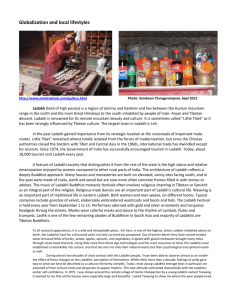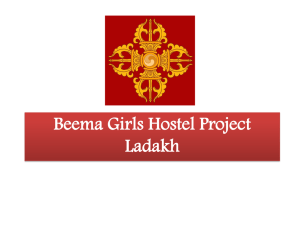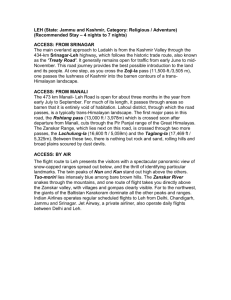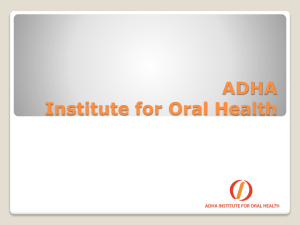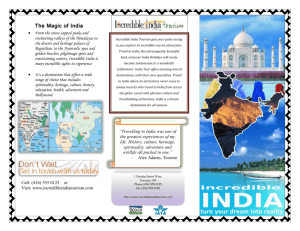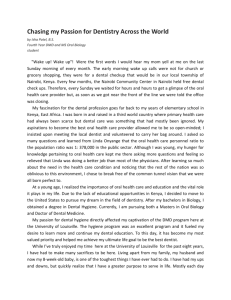Amchi Project
advertisement
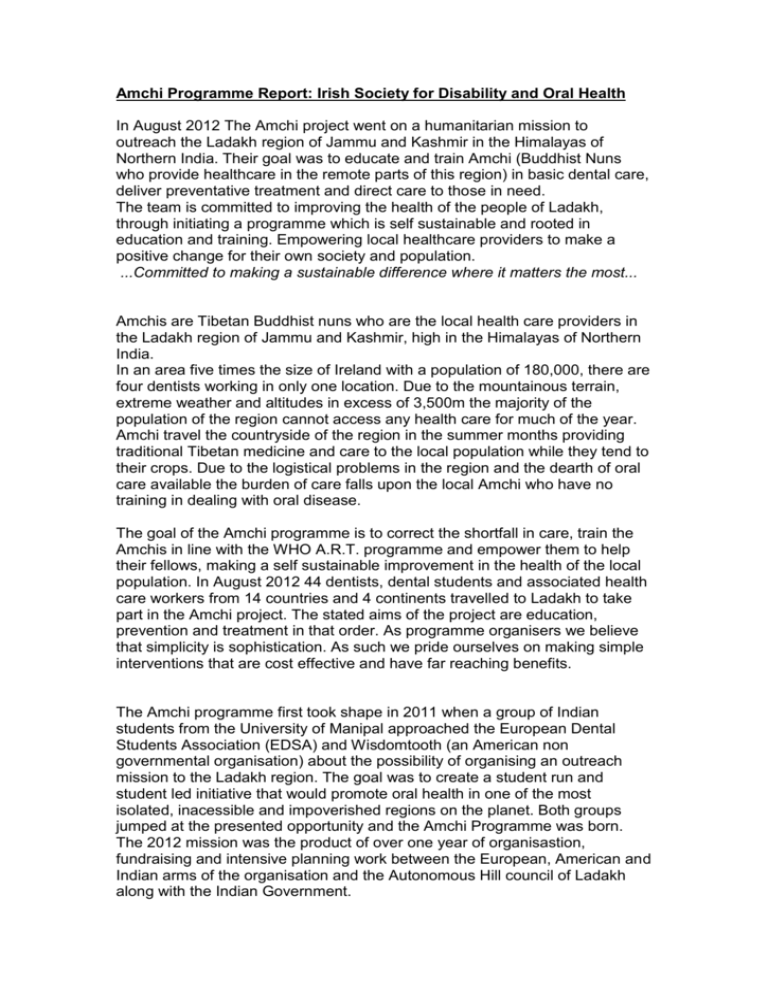
Amchi Programme Report: Irish Society for Disability and Oral Health In August 2012 The Amchi project went on a humanitarian mission to outreach the Ladakh region of Jammu and Kashmir in the Himalayas of Northern India. Their goal was to educate and train Amchi (Buddhist Nuns who provide healthcare in the remote parts of this region) in basic dental care, deliver preventative treatment and direct care to those in need. The team is committed to improving the health of the people of Ladakh, through initiating a programme which is self sustainable and rooted in education and training. Empowering local healthcare providers to make a positive change for their own society and population. ...Committed to making a sustainable difference where it matters the most... Amchis are Tibetan Buddhist nuns who are the local health care providers in the Ladakh region of Jammu and Kashmir, high in the Himalayas of Northern India. In an area five times the size of Ireland with a population of 180,000, there are four dentists working in only one location. Due to the mountainous terrain, extreme weather and altitudes in excess of 3,500m the majority of the population of the region cannot access any health care for much of the year. Amchi travel the countryside of the region in the summer months providing traditional Tibetan medicine and care to the local population while they tend to their crops. Due to the logistical problems in the region and the dearth of oral care available the burden of care falls upon the local Amchi who have no training in dealing with oral disease. The goal of the Amchi programme is to correct the shortfall in care, train the Amchis in line with the WHO A.R.T. programme and empower them to help their fellows, making a self sustainable improvement in the health of the local population. In August 2012 44 dentists, dental students and associated health care workers from 14 countries and 4 continents travelled to Ladakh to take part in the Amchi project. The stated aims of the project are education, prevention and treatment in that order. As programme organisers we believe that simplicity is sophistication. As such we pride ourselves on making simple interventions that are cost effective and have far reaching benefits. The Amchi programme first took shape in 2011 when a group of Indian students from the University of Manipal approached the European Dental Students Association (EDSA) and Wisdomtooth (an American non governmental organisation) about the possibility of organising an outreach mission to the Ladakh region. The goal was to create a student run and student led initiative that would promote oral health in one of the most isolated, inacessible and impoverished regions on the planet. Both groups jumped at the presented opportunity and the Amchi Programme was born. The 2012 mission was the product of over one year of organisastion, fundraising and intensive planning work between the European, American and Indian arms of the organisation and the Autonomous Hill council of Ladakh along with the Indian Government. The programme ethos is in line with the now cliched notion of ‘give a man a fish and he can eat for a day, teach a man to fish and he can eat for a lifetime’. In the programme we are steadfast in our belief that by empowering the local population we are providing them with skills that can be used well beyond our time spent in the region. Although these nuns have no formal medical training it is the belief of the programme organisers that with support and teaching they can provide prophylactic and basic dental care to the population. In 2012, 44 dentists, dental students, medics and support staff from 4 continents and 15 countries arrived in Ladakh determined to make a difference. Although there were varying levels of clinical experience from professors to second year dental students each person in the group made a significant contribution. Prior to the arrival of the team in the area an intensive advertisement campaign was carried out to inform the local population that there would be dental teams in the area. It was also during this time that group members were in contact with various medical and administrative personnel in the region to ensure that they were fully aware of any unique circumstances that may be faced while working in Ladakh. The information obtained during these meetings would prove to be invaluable as the team were operating within the region. The team initially worked in Leh in the central hospital. Upon arrival in the hospital all patients were triaged by a senior clinical staff member (a qualified dentist with 10 years or more experience). The patients were then divided according to the treatment they would need to receive. All patients who were receiving an invasive procedure were given a cardiovascular exam by a qualified medical practioner as the incidence of rheumatic heart disease is very high among the population and in a region so remote with such poor acess to any form of medical care infective endocarditis would be a death sentence. The team were acutely aware that first we must do no harm and that extra lengths must be employed to attempt to reduce the likelyhood and ramifications of any complications. Once the patients were treated they were provided with post operative instructions in their native tongue and any required medication. It was also one of our main objectives to ensure that our work was as far reaching as possible and that we educated as many members of the population as was feasible; While patients were waiting for treatment, team members distributed tooth brushes and provided oral hygiene advice. Any patient who attended the hospital and did not require treatment was provided with oral hygiene advice as well, parents were taught how to brush their childrens teeth and the importance of a non cariogenic diet was explained and stressed. The Amchi programme is in a unique position in Ladakh, in that the explosion in caries in the population has only occurred in recent years with the introduction of refined carbohydrates and western dietary practices. The local dentist in the main town told us that his experience is that there has been a huge increase in caries rates in the last 20 years. In effect what this means is that parents have low caries rates and ate the traditional diet while their children have a high caries rate thanks to the new foodstuffs they consume. We are fortunate that we can use such a stark contrast between the oral health of the partents compared to their children as a motivating factor for parents who control the diet and shape behaviours of their children. After the first day the group split and part of team travelled on a 3 day outreach mission to Panamik. A town approximately 10km from the Pakistan border, and the last outpost to which non Indian nationals are allowed travel. The trip from Leh to Panamik took the team 8 hours. The team was also required to travel the highest motorable road in the world, the Khardung La pass (5,602 m). When they departed Leh it was a warm sunny morning, however when at the top of the pass there was a snow storm! Once in Panamik the team saw a large number of patients. In Panamik every school child received a toothbrush and oral health education. Direct care was also carried out; disciplines provided were periodontal, paedodontal, oral surgery and restorative. Many patients required multi disciplinary care. Also at the behest of the Indian government some project members carried out water analysis to assess fluoride concentration levels in the drinking water. Panamik is well known locally for hot springs that are associated with geothermal vents. It was speculated however that the local rock type had a very high mineral content, which caused dental fluorosis (which was very evident among the local population). The results of that research have been shared with the Indian government. Upon the teams return from Panamik the remainder of the team travelled on a second 3 day outreach mission. The location for this outreach was Tangtse a town on the Chinese border, one where there was a very large number of Tibetan refugees. Again treatment was provided directly, but also prevention and education were carried out. Again in Tangtse tooth brushes and oral hygiene instruction were provided to all school children. The patients in Tangtse presented a unique risk, as there was a very high incidence of hepatitis, especially among the Tibetan refugee population. The medical team gave all patients who would incur invasive treatment a hepatitis screening. This allowed the identification of high risk patients for treatment but more importantly allowed identifiation of these patietns who were then referred to the local medical services. Although universal precautions were used throughout the mission, the incidence was so high (estimated at 25% by local health care workers) that our medical team felt it was a necessary adjunct in the treatment of that population. Further investigation into this finding upon our return and consulatation with experts in the field has identified a significant group of patients in Europe who originate from the Asian subcontinent and have hepatitis, their only common risk factor being having received treatment in dental camps earlier in life. In light of these findings the hepatitis screeening initiative has been extended for the 2013 programme to include all patients receiving invasive treatment. While the second half of the group was treating in Tangste the group that returned from Panamik began working in schools around Leh. The children treated were aged between 4 and 15 years. All of the children in 3 schools in Leh were assessed, given oral hygiene instruction and provided with a toothbrush. Special posters were made by our Indian colleagues who used well known Disney characters to provide oral hygiene instruction in various local languages. For the children who required treatment basic restorations were provided and where indicated fissure sealants were applied to susceptible fissures. It was also at this time that the training of the Amchi Nuns was carried out. It is hoped that as the programme progresses that the amount of direct care we provide will decrease and the amount of care provided by the Amchi will increase. In these first sessions the Amchi were taught the rudiments of dental examination. It is hoped that as the months pass their abilities will improve significantly and eventually they will be able to provide basic treatment. Although as discussed earlier direct care is the distant third objective of the Amchi Programme, our team managed to treat 1,200 adults in the direct care camps and 1,500 children received treatmetn in the schools programme. The adaptability of the Amchi Programme is one of its major strengths. From an organisational standpoint evaluation and constant improvement is key. At the end of the 2012 mission we as programme organisers felt that we had accomplished a lot, however, we also felt that various changes were needed and would help the project into the future. At the end of the trip all team members carried out a survey that allowed us to assess how the group felt we had performed. Also feedback was provided to the group from the local dentists based in Leh and also from the local health authority. In addition to this, feedback and appraisal meetings were held between those involved in the organisation and running of the project before the team parted company. Using this information we were able to make some subtle changes for 2013 that we believe will make a significant difference going forward. The first big advantage of the 2013 mission over the 2012 mission is that there is a core of the group who have travelled to the region before, have worked in the difficult climate and know what to expect. This is a great help from a planning point of view, and to aid logistics and operational procedures on the ground once the team gets to Ladakh. One of the phrases used frequently in presentations and literaure pertaining to the Amchi Programme is sustainability. This refers to sustainability of the programme, the effect of the care and the method through which we aim to make our positive impact. Since the initial mission we have become aware that sustainabity is also required in organisation of the programme. To that end organisational templates and protocols for all elements of the programme from fundraising to team selection, medical organisation and travel arrangements. The aim of producing this literature is not a prescriptive outlining the running of future cylces of the Amchi Porgramme, rather that it should make roles wihin the programme easier to fulfill and less daunting for prospetive members of organisational commitees. Another key change we will make in 2013 is that we will train the Amchi for a much longer period of time. From May 2013 to July 2013 there will be a constant Amchi programme presence in the region, as small groups of qualified dentists travel the region with the Amchi nuns as they work. It is hoped that during this time the Amchi will receive the training and support they need. The next change envisaged is the promotion of the Amchi Smiles programme. The Amchi Smile programme will be trialled on the 2013 mission, with a view to future expansion. The aim of the Amchi Smiles is to increase oral hygiene, decrease communicable disease and raise cultural awareness. The programme will work by having a school in Western Europe or the United States sponsor a school in Ladakh. It is suggested that a local member of the Amchi programme will travel to that school (in the West) and provide oral hygiene advice to the school children while also telling them a little about the school they are sponsoring in Ladakh. Meanwhile in Ladakh a programme will be conducted with the potential for a huge change to be created in the oral health of the local population. This will be done through a process of supervised handwashing and tooth brushing during school, every day at lunch time. All the materials needed will be paid for the sponsoring school and all the material will remain in the Ladakhi school. A similar initiative carried out in the Philippines led to a 50% reduction in school absence and communicable disease and a 40% reduction in tooth decay, all for a cost of only 70 US cents per child per year! It is hoped that with the permission of the local health authority we will be allowed to train the local immunisation nurses in providing oral hygiene and fissure sealants. It is envisaged that when the nurses are visiting the young children in the region they can educate the mothers about oral hygiene and provide fissure sealants for siblings of an appropriate age. The immunisation nurses are uniquely placed to deliver such an intervention as they have access to every child in the region intermittantly throughout their formative years. Provision of high speed non vacuume autoclaves through one of our sponsors will also allow our camps to work with increased efficiency, speed and safety. The final new initative for the 2013 mission is the use of a vehicle to travel out from our outreach locations to even more remote areas to provide OHI and Fissure sealants to the most isolated homesteads of the region. It is hoped that by introducing this initiative we will be able to reach even the most isolated people. We hope that by incorporating these changes into the programme for 2013 that a real and sustainable change can be made to the oral health of the local population. It is also hoped that the programme can continue to build upon the success of 2012 and allow for a more effective 2013. Starting life as an idea of a student in 2011, to realisation as the Amchi Project in 2012, through evolution, improvement and change aimed at sustainability the Amchi Programme has developed. This unique student led, student ran project aimed at making a sustainable difference has already started to make a significant change for the better in the region we serve. We are hugely grateful to all of our supporters, sponsors and experts who have given freely of their time and expertise to guide and aid our team in our task of making a sustainable improvement of the oral health in one of the most isolated and remote populations on the roof of the world.


